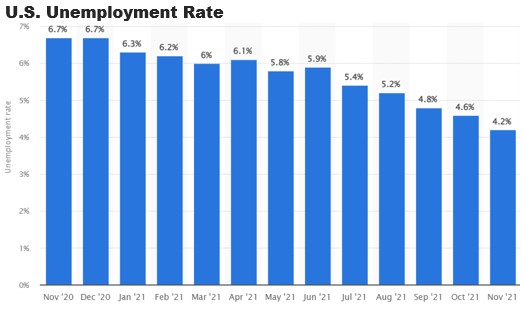The US jobs market is strong and getting stronger by just about any metric you can pick. The labor market is extremely tight so employers are hanging on to existing workers as best they can. Still, a record 4.5 million Americans voluntarily left their jobs in November, according to the Bureau of Labor Statistics.
This pushed the “quits rate” to 3%, matching the high from last September. The high quits rate is a symptom of the tight labor market where workers can quickly find a new – and potentially better – job with relatively little effort.
Workers were most likely to quit their jobs in the hospitality industry, which had by far the highest quits rate at 6.1% in November, as well as those in healthcare. The numbers in transportation, warehousing and utilities also increased.
“Workers continued to quit their jobs at a historic rate. The low-wage sectors directly impacted by the pandemic continued to be the source of much of the elevated quitting,” said Nick Bunker, director of research at the Indeed Hiring Lab, in emailed comments.
The big question for 2022 is whether this dynamic will persist.
The November data released Tuesday doesn’t yet factor in the arrival of the Omicron variant on US shores, which pushed infections higher and put many workers at risk to contract the virus at their places of work.
Case in point, the UCLA Labor Center said in a report also published Tuesday that nearly a quarter of fast-food workers in the Los Angeles area contracted Covid over the past 18 months. Less than half of them had been notified by their employers that they had been potentially exposed to the virus.
Including layoffs and discharges, the number of total separations was 6.3 million in November. Hotels and restaurants registered the biggest increase in separations, while also logging the biggest decline in open jobs, the data showed.
America had 10.6 million jobs to fill in November, a slight decline compared with just over 11 million job openings in October. Unfilled US jobs peaked at 11.1 million last July. Positions in finance and insurance, as well as in the federal government, increased in November.
Hires were little changed at 6.7 million in November and that paints a positive picture of the labor market:
“People who quit are taking other jobs, not leaving the workforce,” said Heidi Shierholz, chief economist at the Economic Policy Institute in a tweet Tuesday. “On net, the labor market is gaining a ton of jobs every month.”
Weekly Jobless Benefits Claims Fall To 52-Year Low
The average number of weekly jobless benefits claims over the most recent four weeks fell to 199,250. That’s the lowest four-week moving average since October 1969, 52 years, the Labor Department reported at the end of December.
The number of continued claims, counting workers who have applied for benefits for at least two consecutive weeks, stood at 1.7 million in the week ended December 18, the lowest level since March 2020.
The US unemployment rate has now fallen to 4.2%, the lowest level since March 2020. Eighteen states had unemployment rates lower than the US average, while 17 states and the District of Columbia had higher rates. The remaining 15 states’ rates were not significantly different from that of the US. The largest overall job gains in November came in Texas, Florida and California.
Employment increased year over year in 49 states and the District of Columbia and was essentially unchanged in one state. The jobs market is booming.
All these data points are undeniably signs of strength in the labor market, even though the recent claims plunge might overstate the actual improvements in the job market. The winter holidays add some volatility to the numbers, according to PNC chief economist Gus Faucher.
Even accounting for this volatility, the bottom line is this: America is back to work.
“Demand for labor is very strong and workers are in short supply, so businesses are not laying off employees,” Faucher said. “Those workers who do find themselves unemployed can quickly find new jobs.”
Even so, the pandemic isn’t over so there’s always some dark clouds on the horizon. At the moment, that’s the highly infectious Omicron variant which is spreading rapidly. So far, the spike in Covid cases from Omicron hasn’t shown up in the jobs data — but that doesn’t mean it won’t.
“It’s a substantial downside near-term risk to the outlook for job growth,” Faucher said. “If consumers change their behavior and pull back on their spending, particularly on services, job growth could slow dramatically in early 2022.” But that remains to be seen.
The bottom line is the jobs market is hitting on all cylinders and the shortage of available workers continues. This means wages will likely have to go even higher, keeping upward pressure on inflation. While I still don’t see US inflation rising significantly higher this year, it may not come down much either. The economy is strong and looks like the trend will continue.


Sorry, comments are closed for this post.